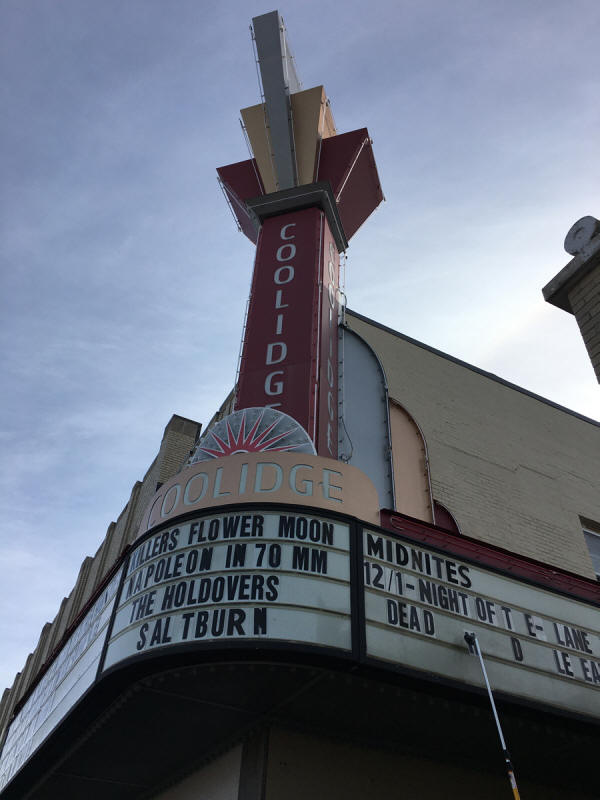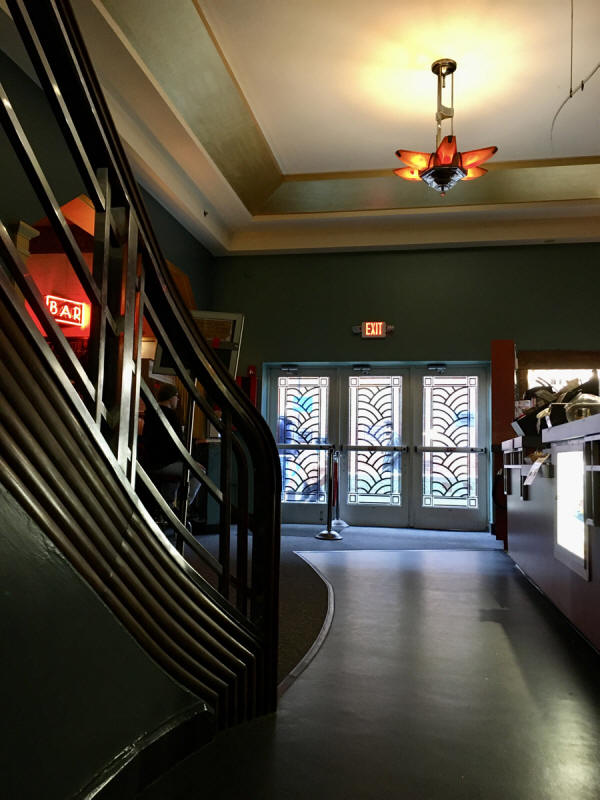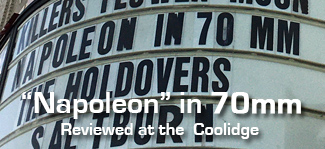"Napoleon" in 70mm at the Coolidge Theatre in
Brookline, MA, USA |
Read more at in70mm.com The 70mm Newsletter |
| Written and photographed by: Jonathan Kleefield, M.D. | Date: 27.11.2023 |
 The
Coolidge Theatre in Brookline, MA The
Coolidge Theatre in Brookline, MAWith the encouragement of our Editor, and favorable late fall weather, yesterday I took the opportunity to walk the 3.3 miles from my home to the Coolidge Theatre in Brookline, MA. I have patronized this wonderful showplace on previous occasions. For those unfamiliar with it, the theatre was opened in 1933, after opposition of the town for the potential deleterious influence a “moving picture theatre” might have on the local populace. The theatre was built from a church converted for theatrical purposes. Originally a single screen theatre, decades later, a second theatre was added by closing off the balcony. Despite several near closures, the enthusiasm of a few generous souls rescued the facility, which was repurposed to show a mixture of “classic” and current films, as well as subjects typically seen in “art houses.” • Go to gallery "Napoleon" in 70mm at the Coolidge Theatre The main theatre, where "Napoleon" was being shown, has around a 400 seat capacity, yet for this Sunday showing, there were only about 50 people in attendance. This was surprising to me, given that only five 70mm prints of Sir Ridley Scott’s latest epic were struck by Fotokem. I would have expected more cinephiles, given the sophistication of the Boston film community. The theatre and lobby are in an Art Deco motif, and the photos clearly show the attention given to the lovely decorative painting and gold leaf in the theatre. However, the seats are more modern, and very comfortable, with cup holders, and have a rich red velour covering. The head projectionist informed me that the film was being displayed by the very best- namely, a pair of Norelco AAII 35/70 projectors. Sound was via a DTS system, with the discs loaded onto a XD50 processor. A large array of surround speakers were clearly visible. The floor manager told me that the film was projected in the “conventional” fashion, namely individual reels, rather than a platter configuration. The projection team had to manually insert cue marks at the end of each reel. The changeovers were absolutely flawless. I am not a historian, and therefore assumed Mr. Scott adhered to the truth in describing Napoleon’s rise to power, starting as a mere gunnery officer to gain his first triumph at the Battle of Toulon. His lust for power and ascension to the created position of Emperor was eerily reminiscent of that of Hitler. Like the Fuhrer, Napoleon used violent means to increase his control, and similarly, his downfall was caused by his belief that he could conquer Russia. In both cases, the Russian winter stopped them, with resultant massive losses for their armed forces. While Hitler committed suicide, Napoleon “got off easy”, having been exiled in palatial surroundings. The human cost of his recklessness was shown by Scott at the end of the movie, listing the millions of casualties caused by his battle tactics, arising mostly from the Russian campaign. |
More in 70mm reading: Gallery "Napoleon" in 70mm at the Coolidge Theatre "Napoleon" in 7OMM “Napoleon”: The North American 70mm Engagements Kevin Brownlow: “EST VOUS MONSIEUR GANCE?” "Oppenheimer" Reviews A Nostalgic View of 70mm in New York City - 1950-1970 Eighteen Years Later DP70s in Massachusetts (MA) DP70s at the Vista in70mm.com's Library Presented on the big screen in 7OMM Peripheral Vision, Scopes, Dimensions and Panoramas |
 The
Coolidge Theatre in Brookline, MA The
Coolidge Theatre in Brookline, MAConcerning the film quality, the Norelco machines, under expert guidance performed flawlessly, with a rock steady image, and very minimal perceived flicker, the latter only noticeable when there were large white areas in the picture. The film gates were spotless, and the print almost entirely free of dust. There was no perceptible film grain. However, I am aware that this print represented a conversion of a digital image source to this analog medium. What I found disappointing was the perceived image sharpness, and worse, the lack of true black in scenes that would have called for it. I believe some of this problem may be the result of the excessive use of backlighting by the Director of Photography. What was equally annoying was the colorists had gone on a rampage, altering the color of nearly the entire film to either a desaturated image with a grey-blue tint, or when in the Egyptian desert, a sickening yellow reminiscent of shades best limited to bathroom fixtures in use. Also, the director of photography was either “encouraged” by Sir Ridley, or was mesmerized by John Alcott’s work in Stanley Kubrick’s 1975 “Barry Lyndon” to shoot endless interior scenes supposedly lit only by candlelight. This use of low light (which admittedly was all one had in the 18th and early 19th centuries) became extremely tiresome to watch. Alternatively, these “period piece” films love to use light streaming in from windows, with the result that the interior details are only visible to a very limited extent. There is a night ship battle scene in the early Toulon sequence that brought a chuckle to me- I believe miniatures, rather than CGI were used, as the waves of water in the foreground were so coarse as to give away the failure of such a small tank to resemble actual water- water is the nemesis for miniature work. Much of the CGI employed (though Sir Ridley says little was used) was variably convincing, but some of the created buildings looked particularly artificial. The CGI artists tasked to depict gore had a field day, early in the picture, again in the Toulon sequence, when Napoleon’s horse is shot in the chest with a cannon ball. The innards catapulting from the poor steed are visible for a few seconds, so hopefully this production did adhere to the usual stipulation that “no animals were harmed during the making of this motion picture” (!). Later on, the responsible cannon ball is retrieved from the dead animal and tossed by Napoleon to another soldier. Also, those who love such stuff will not be disappointed with the opening of this film, depicting the decapitation of Marie Antoinette. The theatre sound quality was excellent. I was able to discern most of the dialog, despite complaints that Joaquin Phoenix, who plays Napoleon, was accused of “mumbling.” Again, kudos to the Coolidge staff for adjusting the sound properly, as well as the sound designers in the film itself. All in all, I found the two hour and 36 minute film absorbing, and for me, educational, as I did not know much about Napoleon before I saw this presentation. I would encourage cineastes to seek out the 1927 film of the same title, by the French film maker Abel Gance, who was incredibly groundbreaking technically, including the use of a three panel “triptych” system to show both panoramas or multiple images simultaneously. Nevertheless, I still feel that aside from the experience of communal viewing, the capabilities of a good home theatre system have the potential to provide better image quality than the “big screen,” as well as sound fidelity quite competitive with that experienced in a large auditorium. |
|
 • Go to Review: "Napoleon" in 70mm at the Coolidge |
|
| Go: back - top - back issues - news index Updated 22-01-25 |
